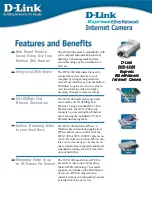
Assembly
Find a suitable place for mounting, from which the area to be monitored can be observed.
A suitable place for installation of this camera has the following features:
• vibration-free
• no direct sunlight
• dry indoor location
☞
Select a place for mounting which is not shielded by, for example, reinforced
concrete walls, steamed up mirrors or metal shelves. No devices with strong
electric fields such as e.g. mobile phones, radio devices, electric motors etc.
must be in the proximity of the camera.
This can influence the radio transmission.
Mounting the radio camera
None of the connection cables must be bent nor squeezed. This can result in
malfunctions, short circuits and defects in the device.
Make sure that cables are not damaged when drilling or bolting into place.
The camera as well as the power supply unit are solely intended for operation
in dry indoor locations.
• Find a suitable location for mounting the camera’s mounting base.
• There are mounting holes at the mounting base. Mark these (e.g. with a pencil) on the wall.
• Drill the holes.
• Attach the mounting base to the wall using suitable mounting material.
• Affix the camera to the mounting base by means of the “screw thread” (2).
• Align the camera as needed.
• Tighten the “locking screw” (3).
☞
Do not point the camera directly toward a source of bright sunlight or towards
strong or indirect illumination as this may lead to overexposure and a fuzzy
picture.
Connecting the radio camera
• Connect the low-voltage plug of the delivered power supply unit to the “DC IN 5 V” (5) power
connection on your wireless camera.
• Plug the power supply unit into a suitable mains socket.
Recharging the internal battery
The camera has an internal lithium-ion battery. It requires a charging time of 2 hours.
To start recharging, connect the low-voltage plug of the power supply unit with the connection
“DC IN 5 V” (5). The status LED “Charge” (4) is lit red during the charging process.
Start-up and setting the camera channels
☞
At the back of the radio camera there is the adjuster, intended to set up the
desired transmission channel for the picture and sound transmission.
On initial operation also observe the operating manual of the radio receiver
thoroughly that is operated jointly with the camera.
If necessary, connect the power supply unit with the camera. The camera can, of course, also
be operated without the power supply unit. In this case, the battery has to be completely
recharged beforehand (charging duration 2 hours).
Select the desired camera channel by turning the “adjuster” (7) into position 1 (= camera chan-
nel 1), position 2 (= camera channel 2), position 3 (= camera channel 3) or position 4 (= camera
channel 4).
As soon as a camera channel has been selected the according status LED “Power” (6) flashes
green. This confirms that the camera is operating.
Turning off the radio camera
To turn off the radio camera, turn the “adjuster” (7) into the position OFF. Following, the red sta-
tus LED “POWER” (6) goes off.
Maintenance and cleaning
Before cleaning the housing of the surveillance camera, separate it from the mains voltage and
disconnect the mains adapter from the mains socket.
To clean the outside of the camera, it is sufficient to use a dry, soft and clean cloth.
Clean the lens very carefully, otherwise you may scratch it. Do not use any aggressive cleaning
agents.
Disposal of used batteries/rechargeable batteries
As a consumer you are required (Battery Directive)to responsibly dispose of all used batteries
and rechargeable batteries;it is forbidden to throw them away with the normal household
waste!
Contaminated batteries/rechargeable batteries are labelled with these symbols to
indicate that disposal in the domestic waste is forbidden. The designations for the
heavy metals involved are: Cd = cadmium, Hg = mercury, Pb = lead.
Used batteries, rechargeable batteries as well as coin cells can be returned to col-
lecting points in your municipality, our stores or wherever batteries/rechargeable
batteries/coin cells are sold!
You thus fulfil your legal obligations and contribute to the protection of the environment!
Technical data
a) Radio camera
Operating voltage:
5 V/DC
Image sensor:
1/3” CMOS
Max. resolution:
628x582 Pixel
Frequency:
2.4 GHz
Radio range:
max. 100 metres (free field)
Range of the IR LEDs max.:
3 m
Integrated litium-ion battery
Recharging internal battery
2 hours
Duration of operation without power unit:
5 hours (IR LEDs deactivated)
2 hours (IR LEDs activated)
Operating temperature:
-10° to +50°
Weight:
110 grams (incl. standing base)
Dimensions (W x H x D):
28 x 90 x 28 mm
b) Camera power supply unit
INPUT:
100-240 V/AC, 50/60 Hz
OUTPUT:
5V DC, 1,000 mA
These operating instructions are a publication by Conrad Electronic SE, Klaus-Conrad-Str. 1, D-92240
Hirschau (www.conrad.com).
All rights including translation reserved. Reproduction by any method, e.g. photocopy, microfilming, or
the capture in electronic data processing systems require the prior written approval by the editor.
Reprinting, also in part, is prohibited.
These operating instructions represent the technical status at the time of printing. Changes in
technology and equipment reserved.
© Copyright 2008 by Conrad Electronic SE.


























